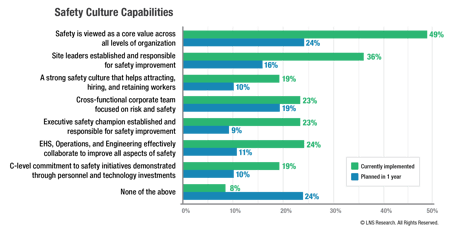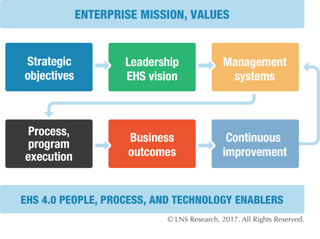When it comes to safety, one thing most people agree on is that it starts at the top. If safety is not a top priority for senior management, including the C-level, an organization is sure to fall short of achieving their stated objectives. Even in companies that tout a strong commitment to safety, there is often a disconnect between what the leaders say and their actions.
Click here to speak with Peter Bussey
This disconnect often boils down to organizational culture and how it shapes, sustains and manifests in the conduct of day-to-day business. No matter how well-crafted a company’s safety policies, or how well-designed its occupational health and safety management systems, the prevailing culture can make or break their implementation.
In this post we will discuss what environment, health, and safety (EHS) and operations leaders can do to improve the situation.
The Gap Between Good Intentions and Execution
 LNS Research surveys of manufacturers show that 49% of companies say that safety is a core value across all levels of their organization. The survey results are a definite sign that protecting workers and safeguarding operations is a business priority of senior executives, operations leaders and frontline workers alike.
LNS Research surveys of manufacturers show that 49% of companies say that safety is a core value across all levels of their organization. The survey results are a definite sign that protecting workers and safeguarding operations is a business priority of senior executives, operations leaders and frontline workers alike.
However, good safety intentions only go so far and need to be backed by real organizational support. Our data shows that when it comes to safety, there’s still a disconnect between stated intentions and execution. Only 19% of respondents report that their organization has C-level executive commitment to safety, as demonstrated by investments in staff and technology. This gap in “walking the talk” reflects an organizational culture that is not entirely supportive of safety and helps explain why industrial organizations continue to struggle with safety in general and EHS performance overall.
The Link Between Culture and Operational Performance
 There’s a lot of evidence linking organizational culture and operational performance. For example, many companies have implemented continuous improvement initiatives such as Lean to achieve operational excellence goals. Among manufacturing operations implementing Lean, research shows that plants with specific organizational culture characteristics such a collective attitude, people orientation, continuous improvement focus, and collaboration perform much better than plants without these traits.
There’s a lot of evidence linking organizational culture and operational performance. For example, many companies have implemented continuous improvement initiatives such as Lean to achieve operational excellence goals. Among manufacturing operations implementing Lean, research shows that plants with specific organizational culture characteristics such a collective attitude, people orientation, continuous improvement focus, and collaboration perform much better than plants without these traits.
Companies with best-in-class EHS and safety performance actively build and sustain a culture that considers EHS to be as important as business performance. This type of culture starts with active leadership from senior management, with employees throughout the organization taking ownership and contributing. This notion is validated by our work at LNS Research, and by surveying best practices put forth by leading organizations such as the Campbell Institute of the National Safety Council, the Health and Safety Executive (HSE), and the Institution of Occupational Safety and Health (IOSH).
Help Top Management Step Up
Realizing and sustaining a culture of safety and operational excellence is a challenging, yet a necessary undertaking to attain EHS goals. Effective organizational change management requires a disciplined approach and dedicated resources. Above all, it requires active involvement and commitment of top management, starting with the CEO.
Here are three strategies EHS and operations leaders can use to facilitate executive buy-in:
Establish Top-Down Clarity of Vision
Culture change involves fundamental organizational change. The only way such a change will occur is if there is a clear vision from senior leadership backed by consistent executive action. As an EHS leader, you must facilitate such an awakening if it hasn’t already occurred.
Make EHS Mainstream
Our research shows that lack of cross-functional collaboration is one of the key barriers to EHS performance improvement. Organizational silos are still prevalent, and in fact, it seems that some EHS leaders prefer to maintain that status quo. To help change this, EHS should engage with corporate initiatives focused on operational improvement (e.g., Lean, six Sigma, operational excellence) and Digital Transformation. These initiatives have executive sponsorship and funding and are an excellent way to elevate and integrate EHS into the business.
Show Them the Money
Aside from generally wanting to “do the right thing,” business leaders recognize the potential impact of safety performance on productivity, reputation, profitability, and desirability as an employer and business partner. Help senior executives commit the necessary resources by showing how investments in safety will help achieve the organization’s strategic objectives and quantify the return on investment. Depending on the capabilities of your organization and EHS, the value to emphasize may be tactical like avoiding the direct costs of incidents, or it may be strategic such as facilitating profitable growth.
If you are interested in how organizational culture can be used to improve safety and operational performance, join LNS Research on February 22 for a webcast, “Harness Organizational Culture for EHS Performance and Operational Excellence”.